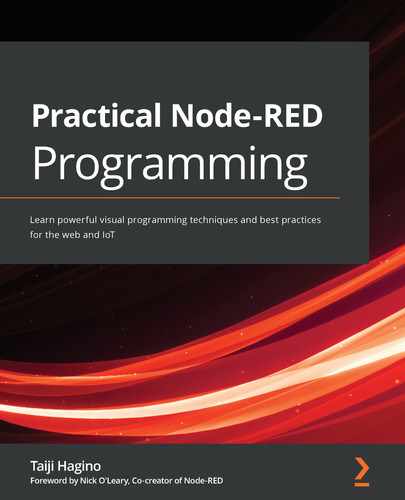Use a low-code programming approach to create event-driven applications from scratch by wiring together hardware devices, APIs, and online services Node-RED is a free and open source flow-based programming tool used to handle IoT data that allows programmers of any level to interconnect physical I/O, cloud-based systems, databases, and APIs to build web applications without code. Practical Node-RED Programming is a comprehensive introduction for anyone looking to get up to speed with the Node-RED ecosystem in no time. Complete with hands-on tutorials, projects, and self-assessment questions, this easy-to-follow guide will help you to become well versed in the foundations of Node-RED. You'll learn how to use Node-RED to handle IoT data and build web applications without having to write complex code. Once you've covered the basics, you'll explore various visual programming techniques and find out how to make sample flows as you cover web development, IoT development, and cloud service connections, and finally build useful real-world applications. By the end of this book, you'll have learned how to use Node-RED to develop a real-world application from scratch, which can then be implemented in your business. This Node-RED book is for web developers and IoT engineers with some background in JavaScript and Node.js. Although not necessary, familiarity with the concepts of electronics will help you to make the most out of this book.Key Features
Book Description
What you will learn
Who this book is for
Table of Contents
- Practical Node-RED Programming
- Foreword
- Contributors
- About the author
- About the reviewers
- Preface
- Section 1: Node-RED Basics
- Chapter 1: Introducing Node-RED and Flow-Based Programming
- Chapter 2: Setting Up the Development Environment
- Chapter 3: Understanding Node-RED Characteristics by Creating Basic Flows
- Chapter 4: Learning the Major Nodes
- Section 2: Mastering Node-RED
- Chapter 5: Implementing Node-RED Locally
- Technical requirements
- Running Node-RED on a local machine
- Using the standalone version of Node-RED
- Using IoT on edge devices
- Making a sample flow
- Use case 1 – light sensor
- Use case 2 – temperature/humidity sensor
- Making a flow for use case 1 – light sensor
- Making a flow for use case 2 – temperature/humidity sensor
- Summary
- Chapter 6: Implementing Node-RED in the Cloud
- Technical requirements
- Running Node-RED on the cloud
- What is the specific situation for using Node-RED in the cloud?
- IoT case study spot on the server side
- Use case 1 – Storing data
- Use case 2 – Temperature/humidity sensor
- Making a sample flow
- Making a flow for use case 1 – storing data
- Making a flow for use case 2 – visualizing data
- Summary
- Chapter 7: Calling a Web API from Node-RED
- Technical requirements
- Learning about the RESTful API
- Learning about the input/output parameters of a node
- How to call the web API on a node
- Creating an account
- Creating an API key
- Checking the API endpoint URL
- Checking that the API can run
- Creating the flow calling the API
- How to use the IBM Watson API
- Logging in to IBM Cloud
- Starting Node-RED on IBM Cloud
- Creating the Watson API
- Connecting Node-RED and the Tone Analyzer service
- Creating the flow by calling the Tone Analyzer API
- Testing the flow
- Summary
- Chapter 8: Using the Project Feature with Git
- Section 3: Practical Matters
- Chapter 9: Creating a ToDo Application with Node-RED
- Chapter 10: Handling Sensor Data on the Raspberry Pi
- Technical requirements
- Getting sensor data from the sensor module on the Raspberry Pi
- Preparing the devices
- Checking Node-RED to get data from the sensor device
- Learning the MQTT protocol and using an MQTT node
- Connecting to an MQTT broker
- Mosquitto
- Preparing Mosquitto on your Raspberry Pi
- Making a flow to get sensor data and send it to the MQTT broker
- Checking the status of data on the localhost
- Summary
- Chapter 11: Visualize Data by Creating a Server-Side Application in the IBM Cloud
- Chapter 12: Developing a Chatbot Application Using Slack and IBM Watson
- Chapter 13: Creating and Publishing Your Own Node on the Node-RED Library
- Technical requirements
- Creating your own node
- Node program development
- Node packaging
- Testing your own node in a local environment
- Node installation
- Node customization
- Publishing your own node as a module in the Node-RED Library
- Publishing the node you created
- Deleting the node you published
- Installing the node you published
- Summary
- Appendix: Node-RED User Community
- Other Books You May Enjoy
